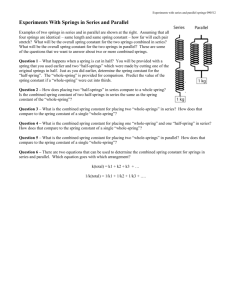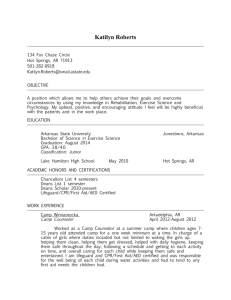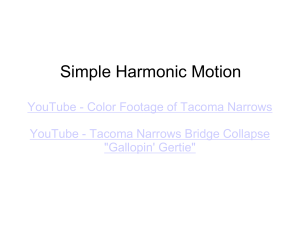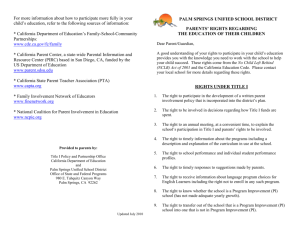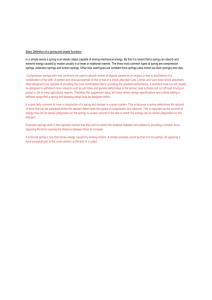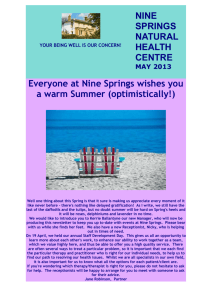Results and Discussion
advertisement
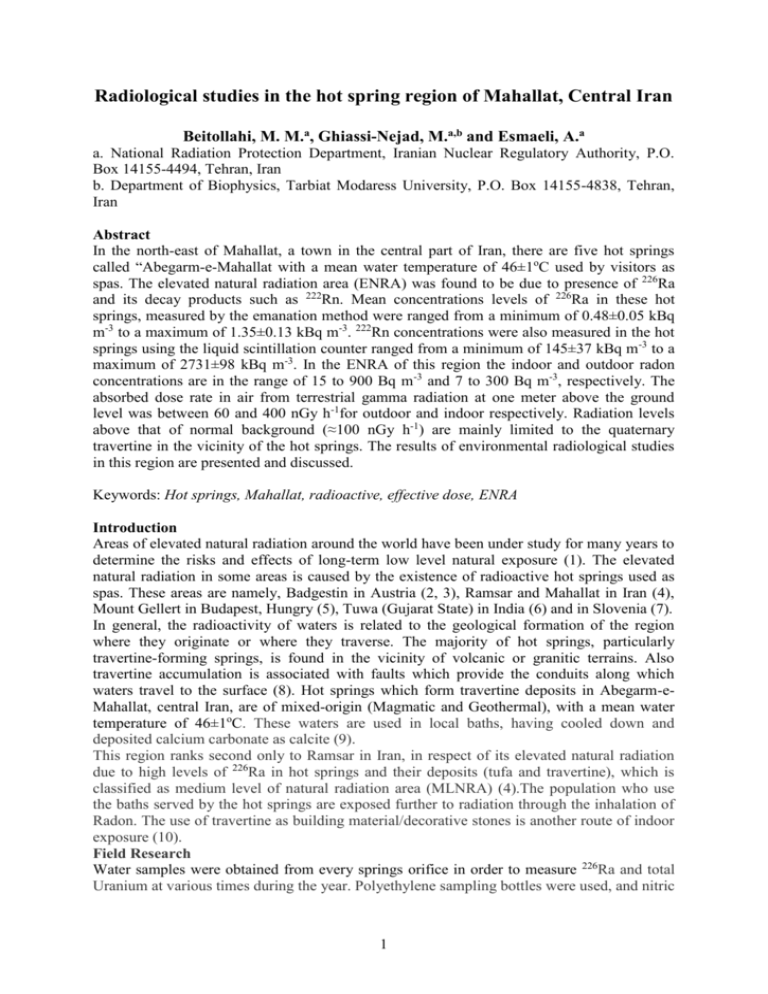
Radiological studies in the hot spring region of Mahallat, Central Iran Beitollahi, M. M.a, Ghiassi-Nejad, M.a,b and Esmaeli, A.a a. National Radiation Protection Department, Iranian Nuclear Regulatory Authority, P.O. Box 14155-4494, Tehran, Iran b. Department of Biophysics, Tarbiat Modaress University, P.O. Box 14155-4838, Tehran, Iran Abstract In the north-east of Mahallat, a town in the central part of Iran, there are five hot springs called “Abegarm-e-Mahallat with a mean water temperature of 46±1oC used by visitors as spas. The elevated natural radiation area (ENRA) was found to be due to presence of 226Ra and its decay products such as 222Rn. Mean concentrations levels of 226Ra in these hot springs, measured by the emanation method were ranged from a minimum of 0.48±0.05 kBq m-3 to a maximum of 1.35±0.13 kBq m-3. 222Rn concentrations were also measured in the hot springs using the liquid scintillation counter ranged from a minimum of 145±37 kBq m-3 to a maximum of 2731±98 kBq m-3. In the ENRA of this region the indoor and outdoor radon concentrations are in the range of 15 to 900 Bq m-3 and 7 to 300 Bq m-3, respectively. The absorbed dose rate in air from terrestrial gamma radiation at one meter above the ground level was between 60 and 400 nGy h-1for outdoor and indoor respectively. Radiation levels above that of normal background (≈100 nGy h-1) are mainly limited to the quaternary travertine in the vicinity of the hot springs. The results of environmental radiological studies in this region are presented and discussed. Keywords: Hot springs, Mahallat, radioactive, effective dose, ENRA Introduction Areas of elevated natural radiation around the world have been under study for many years to determine the risks and effects of long-term low level natural exposure (1). The elevated natural radiation in some areas is caused by the existence of radioactive hot springs used as spas. These areas are namely, Badgestin in Austria (2, 3), Ramsar and Mahallat in Iran (4), Mount Gellert in Budapest, Hungry (5), Tuwa (Gujarat State) in India (6) and in Slovenia (7). In general, the radioactivity of waters is related to the geological formation of the region where they originate or where they traverse. The majority of hot springs, particularly travertine-forming springs, is found in the vicinity of volcanic or granitic terrains. Also travertine accumulation is associated with faults which provide the conduits along which waters travel to the surface (8). Hot springs which form travertine deposits in Abegarm-eMahallat, central Iran, are of mixed-origin (Magmatic and Geothermal), with a mean water temperature of 46±1oC. These waters are used in local baths, having cooled down and deposited calcium carbonate as calcite (9). This region ranks second only to Ramsar in Iran, in respect of its elevated natural radiation due to high levels of 226Ra in hot springs and their deposits (tufa and travertine), which is classified as medium level of natural radiation area (MLNRA) (4).The population who use the baths served by the hot springs are exposed further to radiation through the inhalation of Radon. The use of travertine as building material/decorative stones is another route of indoor exposure (10). Field Research Water samples were obtained from every springs orifice in order to measure 226Ra and total Uranium at various times during the year. Polyethylene sampling bottles were used, and nitric 1 acid was added to the water to prevent the adsorption of radionuclides on to the walls of the sampling vessels. 222 Rn concentration in the hot springs was measured using s Studsvik 2413_A portable Radon sampler. To confirm these measurements other samples were obtained using a Dupont Mineral-oil-Base Scintillator. Samples of travertine, different geological formations and soil were taken to determine their natural radionuclide content. To obtain natural exposure of the area, an Ion Chamber Survey Meter (Smart Ion Model, built by Mini-Instrument Ltd) was utilized. Laboratory Experiments Determinations of 226Ra in spring water were performed using the emanation method (11, 12). Total Uranium content of spring waters were determined, using a Scintrex UA_3 Laser Fluorimeter. 222Rn levels in the same samples were measured using a Beckman 6500 Liquid Scintillator Counter. The exposure rate in air due to natural radio activity at various locations in Abegarm-eMahallat was measured, using an environmental early warning network (SAPOS 90M). This system has three Geiger-Muller counters tube, that each of them sensitive to special altitude of energy. Continue measurement of exposure dose rate from background level to 1.5 MeV (calibration made with 137Cs). 222 Rn is measured in indoor and outdoor of hot spring closed pools and dwellings, using RADOS radon meter system. 226 Ra, 238U, 40K and 232TH levels in the various samples were measured, using gamma spectrometer with high purity germanium (HPGE) detectors (10, 13).Based on the radionuclide content of the soil, the absorbed gamma dose rates were determined using the procedures applied in the literature (14). Results and Discussion Table 1 shows the mean yearly results of total Uranium, 226Ra, 222Rn and temperature of the hot springs which were performed in each season from Autumn 2002 to Summer 2003. Table 1: Mean total Uranium, 226Ra, 222Rn and temperature in the hot springs of Abegarm-eMahallat. (Mean±δ) Sampling Site Shafa Soleymani Donbeh Soda Romatism Total Uranium (ppb) 12.1±5.3 6.0±1.6 5.6±1.2 4.2±1.1 4.0±0.9 226 -3 1.35±0.13 1.09±0.11 1.07±0.12 1.10±0.13 0.48±0.05 222 -3 208±5 47.5±0.6 318±17 46.3±1.0 150±55 46.0±0.8 145±37 45.5±0.6 2731±98 45.0±1.0 Ra (kBq m ) Rn (kBq m ) Temperature (oC) δ =standard deviation Although the levels of 226Ra in these sulphated hot springs (10) are relatively high (approx. 1 kB m-3), they are still insignificant when compared to levels in sulphurous hot springs (a reductive milieu).The 222Rn : 226Ra ratio ranges from a Minimum of 132 at the soda station to a maximum of 5690 at the Romatism site. The mean water temperature in these hot springs is 46±1oC. Table 2 summarizes 226Ra and 222 Rn concentrations in some hot springs known worldwide compared to the hot springs of Abegarm-e-mahallat (4). Table2: 226Ra and 222Rn levels in some hot springs uses as spas with mean values in parenthesis Location Badgetein (Austria) Ramsar (Iran) Mahallat (Iran) No. of Springs 2 20 9 5 Radioactivity Range (kBq m-3) 226 222 Ra Rn 0.04-4.9 (1) 20-4500 (555) 1-146 (31) 1-160 (64.3) 0.48-1.35 (1.02) 145-2731 (710) The mean concentration of 222Rn in the hot springs of mahallat has highest value (710 kBq m-3) while its 226Ra concentration (1.02 kBq m-3) ranks second only to Ramsar. In order to determine the origin of the radioactivity, it was necessary to measure levels of natural radionuclides in different rock and soil samples. This study was performed by Sohrabi, et al., (10, 13) and shows the predominant radioisotope is 226Ra which has been transported from its source (post-lower Miocene granodiorite) and deposited by the hot springs as travertine. There was a positive correlation between 226Ra levels and Iron concentration due to absorbance of 226Ra by the Iron compounds. The predominant natural radionuclide in these soil samples given in tables 3 is 226Ra with a maximum concentration of 7300 Bq kg-1 measure in the Solaymani hot springs region. The calculated gamma absorbed dose rates in air and the measured values have shown a good correlation. Table3: Natural radionuclide contents in soil samples calculated and measured gamma absorbed Hot springs Region Donbeh Romatism Shafa Soda Soleymani dose rates in air in Abegarm-e-Mahallat region. Specific Activity (Bq kg-1) Calculated Dose 226 232 40 Ra Th K rate (µGy h-1) 3 (4.3-6.1)10 15-36 516-721 2.2-3.2 (1.3-2)103 21-35 440-561 0.7-1.1 3 (4.2-4.8)10 30-41 471-543 2.2-2.4 (4.1-5.3)103 23-38 364-539 2.1-2.8 (6.7-7.3)103 17-29 434-873 3.5-3.8 Measured Dose rate (µGy h-1) 2.6-3.5 0.8-1.7 1.7-2.6 1.7-2.6 3.5-5.4 Table 4: Indoor and outdoor 222Rn and Gamma exposure rate (Mean±δ) Hot springs Region Donbeh Romatism Shafa Soda Soleymani Average: 222 Rn (indoor) (Bq m-1) 485±115 570±105 275±106 407±171 700±115 487±160 222 Rn (outdoor) (Bq m-1) 13.5±4 16±3.5 13.7±3.5 20±12 14±4 15.4±2.7 Gamma (indoor) (nGy h-1) Gamma outdoor) (nGy h-1) 220±25 200±23 200±32 200±56 400±65 244±87 150±10 150±8 150±3 150±4 150±12 150±15 The mean concentration of 222Rn and Gamma exposure rate in indoor and outdoor of hot spring’s pools are presented in Table 4. The population of Abegarm-e-Mahallat is about 150 persons that generally they are serving tourists in hot spring’s pools. More than 500,000 tourists are using these hot springs annually. With calculation of occupancy factor and cosmic ray dose and using all measured data of radon and gamma exposure rate effective dose of residents and tourists of this area are achieved. Some formulas from literature of 15, 16, 17 to 3 calculate the results of Table 5, are used. The potential annual effective doses of the public in Abegarm-e-Mahallat range from 4.11 to 7.16 mSv with a mean value of 5.60 ± 1.15 mSv. The distribution of the potential annual effective doses of the public of Abegarm-e-Mahallat due to different sources is shown in Table 5. Table 5: Mean effective dose of residents (Mean±δ) Source of exposure 222 Rn: during work in hot spring’s pool Gamma and cosmic ray: during work in hot spring’s pool Total effective dose in free time Total effective dose effective dose of residents mSv/year 3.23±1.60 0.33±0.11 2.04±0.08 5.60±1.15 Total exposure of any tourist, is obtained about 9.7±2.9 µSv per any trip that 91% of it is caused by 222 Rn, and 9% is from Gamma and cosmic rays. Conclusion Base on the obtained results the following can be concluded: 1. Hot springs in Abegarm-e-Mahallat are responsible for the distribution of radionuclides (especially 226Ra) in the region. 2. The presence of high 222Rn levels in the hot springs leads to population exposure .The travertine used for building and decorative purposes, particularly indoors, can expose an even greater number of people. 3. There is a need for continuous radiological monitoring of such areas. 4. Absorbed doses by the inhabitants of Abegarme-Mahallat are achieved. This data shows that public exposure is just a little more than ICRP limit (5 mSv/year) also tourist’s exposure is lower than ICRP limit. References 1. M. Sohrabi, Procs. 2nd Workshop on Radon Monitoring in Radioprotection Environmental,and/or Earth sciences,ICTP,Trieste ,Italy,25Nov.-6Dec.(1991),G. Furlan and L. Tommasino(eds.),World Scientifitic ,Singapore(1993)98. 2. J.pohl-Ruling, Environment International 19(1993)455. 3. j.pohl-Ruling,F.Steinhausler and E. pohl , procs.2nd Special Symp . on natural Radiation Environment, 19-23 jan . (1981),K,G.Vohra,U.C.Mishra, K.C.pillai and S.Sadasivan(esd),Wiley Eastern Limited, India(1982)107. 4. M.Sohrabi, procs. 4th International Conference on High Levels of Natural Radiation;Beijing ,China ,21-25 Oct.(1996)57. 5. p.Szerbian, Gy . Koteles and D.Stur,Rad. Prot. Dosim. 56(1994)319. 6. L . U Joshi and U .C. Mishra , J .Radioanalytical Chem.,59(1980)672. 7. I. Kobal and A. Renier, Health Phys.53 (1987)308. 8. H . S . Chafetz and R. L. Folk, J.Sed. Petrology 54(1984)289. 9. Y . Lasemi, M .M . Beitollhi , M. Sohrabi and Z. Lasemi(in press). 10. M. Sohrabi, M. M . Beitollahi Y . Lasemi and E. Amin Sobhani, procs .of an Int. Conf . on High Levels of Natural Radiation Ramsar, IR Iran ,3-7 Nov. (1990), M. Sohrabi J . U. Ahmed and S.A. Durrani(eds),IAEA Publication Series (1993)425. 11. D. R. Rushing, W. J. Garcia and D. A. Clark ,in :Procs. Symp. On Radiological Health and Safety, IAEA Sm/412-44,Vienna ,Austria(1963)189. 12. M. Sohrabi, M. Bolourchi, M. M. Beitollahi and J. Amidi Procs. 4th International Conference on High Levels of Natural Radiation;Beijing, China, 4 13. 21-25Oct.(1996),L.Wei, T. Sugahara and Z. Tao(eds), Elsevier Netherlaus (1997)129. 14. K. N. Yu,Z. J. Guan ,M. J. Stokes, and E. C. M. Young,J. of Environmental Radioactivity, 17(1992)31. 15. M. Sohrabi and A. Esmaili, “New public dose assessment of elevated natural radiation areas of Ramsar (Iran) for epidemiological studies” International Congress Series Volume: 1225, February, 2002, pp. 15-24. 16. United Nations Scientific Committee on the Effects of Atomic Radiation, Sources and Effects of Ionizing Radiation, United Nations, New York, 2000. 5

